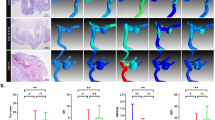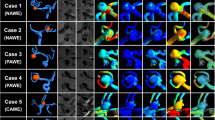Abstract
Although several studies have suggested that aneurysmal wall inflammation and laminar thrombus are associated with the rupture of saccular aneurysms, the mechanisms leading to the rupture remain obscure. We performed full exposure of aneurysms before clip application and attempted to keep the fibrin cap on the rupture point. Using these specimens in a nearly original state before surgery, we conducted a pathological analysis and studied the differences between ruptured and unruptured aneurysms to clarify the mechanism of aneurysmal wall degeneration. This study included ruptured (n = 28) and unruptured (n = 12) saccular aneurysms resected after clipping. All of the ruptured aneurysms were obtained within 24 h of onset. Immunostainings for markers of inflammatory cells (CD68) and classical histological staining techniques were performed. Clinical variables and pathological findings from ruptured and unruptured aneurysms were compared. Patients with ruptured or unruptured aneurysms did not differ by age, gender, size, location, and risk factors, such as hypertension, smoking, and hyperlipidemia. The absence or fragmentation of the internal elastica lamina, the myointimal hyperplasia, and the thinning of the aneurysmal wall were generally observed in both aneurysms. The existence of subintimal fibrin deposition, organized laminar thrombus, intramural hemorrhage, neovascularization, and monocyte infiltration are more frequently observed in ruptured aneurysms. Multivariate logistic regression analysis showed that ruptured aneurysm was associated with presence of subintimal fibrin deposition and monocyte infiltration. These findings suggest that subintimal fibrin deposition and chronic inflammation have a strong impact on degeneration of the aneurysmal wall leading to their rupture, and this finding may be caused by endothelial dysfunction.






Similar content being viewed by others
References
Akiyama Y, Houkin K, Nozaki K, Hashimoto N (2010) Practical decision-making in the treatment of unruptured cerebral aneurysm in Japan: the U-CARE study. Cerebrovasc Dis 30:491-499
Aoki T, Kataoka H, Ishibashi R, Nozaki K, Hashimoto N (2008) Simvastatin suppresses the progression of experimentally induced cerebral aneurysms in rats. Stroke 39:1276–1285
Caplan LR (1998) Should intracranial aneurysms be treated before they rupture? N Engl J Med 339:1774–1775
Chyatte D, Bruno G, Desai S, Todor DR (1999) Inflammation and intracranial aneurysms. Neurosurgery 45:1137–1146, discussion 1146-1137
Frosen J, Marjamaa J, Myllarniemi M, Abo-Ramadan U, Tulamo R, Niemela M, Hernesniemi J, Jaaskelainen J (2006) Contribution of mural and bone marrow-derived neointimal cells to thrombus organization and wall remodeling in a microsurgical murine saccular aneurysm model. Neurosurgery 58:936–944, discussion 936-944
Frosen J, Piippo A, Paetau A, Kangasniemi M, Niemela M, Hernesniemi J, Jaaskelainen J (2004) Remodeling of saccular cerebral artery aneurysm wall is associated with rupture: histological analysis of 24 unruptured and 42 ruptured cases. Stroke 35:2287–2293
Frosen J, Tulamo R, Paetau A, Laaksamo E, Korja M, Laakso A, Niemela M, Hernesniemi J (2012) Saccular intracranial aneurysm: pathology and mechanisms. Acta Neuropathol 123:773–786
Halvorsen AM, Futrell N, Wang LC (1994) Fibrin content of carotid thrombi alters the production of embolic stroke in the rat. Stroke 25:1632–1636
Hasan DM, Mahaney KB, Brown RD Jr, Meissner I, Piepgras DG, Huston J, Capuano AW, Torner JC (2011) Aspirin as a promising agent for decreasing incidence of cerebral aneurysm rupture. Stroke 42:3156–3162
Hasan DM, Mahaney KB, Magnotta VA, Kung DK, Lawton MT, Hashimoto T, Winn HR, Saloner D, Martin A, Gahramanov S, Dosa E, Neuwelt E, Young WL (2012) Macrophage imaging within human cerebral aneurysms wall using ferumoxytol-enhanced MRI: a pilot study. Arterioscler Thromb Vasc Biol 32:1032–1038
Hokari M, Kuroda S, Nakayama N, Houkin K, Ishikawa T, Kamiyama H (2013) Long-term prognosis in patients with clipped unruptured cerebral aneurysms-increased cerebrovascular events in patients with surgically treated unruptured aneurysms. Neurosurg Rev 36(4):567–571
Huber A, Dorn A, Witzmann A, Cervos-Navarro J (1993) Microthrombi formation after severe head trauma. Int J Legal Med 106:152–155
Inoue T, Shimizu H, Fujimura M, Saito A, Tominaga T (2012) Annual rupture risk of growing unruptured cerebral aneurysms detected by magnetic resonance angiography. J Neurosurg 117:20–25
Tsuneo K, Teruyasu H, Yoichi K (2003) Unruptured thrombosed giant aneurysm: strategy for treatment. Surg Cereb Stroke (Jpn) 31:344–348
Kataoka K, Taneda M, Asai T, Kinoshita A, Ito M, Kuroda R (1999) Structural fragility and inflammatory response of ruptured cerebral aneurysms. A comparative study between ruptured and unruptured cerebral aneurysms. Stroke 30:1396–1401
Kazumata K, Kamiyama H, Ishikawa T, Nakamura T, Takizawa K, Komeichi T, Kubota T, K T (2004) Current surgical outcome in poor grade patients with subarachnoid hemorrhage. Surg Cereb Stroke (Jpn) 32:103-106
Kuroda S, Ishikawa T, Hokari M, Nakayama N, Yasuda H, Yoshimoto T, Ushikoshi S, Kazumata K, Itamoto K, Asano T, Aoki T, Kobayashi T, Takikawa S, NIiya Y, Takahashi A, Terasaka S, Aida T, Mabubchi S, Nomura M, Saito H, Kaneko S, Yoshinobu I (2009) Epidemiology, therapy and functional outcome of aneurysmal subarachnoid hemorrhage in Sapporo between 2003-2007: an area-specific, group-based study by Hokkaido University Hospital Group. Surg Cereb Stroke (Jpn) 37:109–115
Lawton MT, Quinones-Hinojosa A, Chang EF, Yu T (2005) Thrombotic intracranial aneurysms: classification scheme and management strategies in 68 patients. Neurosurgery 56:441–454, discussion 441-454
Maeda A, Yamada M, Itoh Y, Otomo E, Hayakawa M, Miyatake T (1993) Computer-assisted three-dimensional image analysis of cerebral amyloid angiopathy. Stroke 24:1857–1864
Martin AJ, Hetts SW, Dillon WP, Higashida RT, Halbach V, Dowd CF, Lawton MT, Saloner D (2011) MR imaging of partially thrombosed cerebral aneurysms: characteristics and evolution. AJNR Am J Neuroradiol 32:346–351
Mizutani T (1996) A fatal, chronically growing basilar artery: a new type of dissecting aneurysm. J Neurosurg 84:962–971
Moe N (1969) The deposits of fibrin and fibrin-like materials in the basal plate of the normal human placenta. Acta Pathol Microbiol Scand 75:1–17
Moe N, Abildgaard U (1969) Histological staining properties of in vitro formed fibrin clots and precipitated fibrinogen. Acta Pathol Microbiol Scand 76:61–73
Moriwaki T, Takagi Y, Sadamasa N, Aoki T, Nozaki K, Hashimoto N (2006) Impaired progression of cerebral aneurysms in interleukin-1beta-deficient mice. Stroke 37:900–905
Nussel F, Wegmuller H, Huber P (1993) Morphological and haemodynamic aspects of cerebral aneurysms. Acta Neurochir (Wien) 120:1–6
Pearse AG (1968) Histochemistry, vol 3rd. J.A. Churchill, London, 642
Rayz VL, Boussel L, Ge L, Leach JR, Martin AJ, Lawton MT, McCulloch C, Saloner D (2010) Flow residence time and regions of intraluminal thrombus deposition in intracranial aneurysms. Ann Biomed Eng 38:3058–3069
Roccatagliata L, Guedin P, Condette-Auliac S, Gaillard S, Colas F, Boulin A, Wang A, Guieu S, Rodesch G (2010) Partially thrombosed intracranial aneurysms: symptoms, evolution, and therapeutic management. Acta Neurochir (Wien) 152:2133–2142
Sato K, Yoshimoto Y (2011) Risk profile of intracranial aneurysms: rupture rate is not constant after formation. Stroke 42:3376–3381
Shim JH, Yoon SM, Bae HG, Yun IG, Shim JJ, Lee KS, Doh JW (2012) Which treatment modality is more injurious to the brain in patients with subarachnoid hemorrhage? Degree of brain damage assessed by serum S100 protein after aneurysm clipping or coiling. Cerebrovasc Dis 34:38-47
Shojima M, Nemoto S, Morita A, Oshima M, Watanabe E, Saito N (2010) Role of shear stress in the blister formation of cerebral aneurysms. Neurosurgery 67:1268–1274, discussion 1274-1265
Shojima M, Oshima M, Takagi K, Torii R, Hayakawa M, Katada K, Morita A, Kirino T (2004) Magnitude and role of wall shear stress on cerebral aneurysm: computational fluid dynamic study of 20 middle cerebral artery aneurysms. Stroke 35:2500–2505
Sonobe M, Yamazaki T, Yonekura M, Kikuchi H (2010) Small unruptured intracranial aneurysm verification study: SUAVe study, Japan. Stroke 41:1969–1977
Tada Y, Yagi K, Kitazato KT, Tamura T, Kinouchi T, Shimada K, Matsushita N, Nakajima N, Satomi J, Kageji T, Nagahiro S (2010) Reduction of endothelial tight junction proteins is related to cerebral aneurysm formation in rats. J Hypertens 28:1883–1891
Tulamo R, Frosen J, Junnikkala S, Paetau A, Kangasniemi M, Pelaez J, Hernesniemi J, Niemela M, Meri S (2010) Complement system becomes activated by the classical pathway in intracranial aneurysm walls. Lab Invest 90:168–179
Wermer MJH, van der Schaaf IC, Velthuis BK, Algra A, Buskens E, Rinkel GJE (2005) Follow-up screening after subarachnoid haemorrhage: frequency and determinants of new aneurysms and enlargement of existing aneurysms. Brain 128:2421–2429
Yamaguchi R, Ujiie H, Haida S, Nakazawa N, Hori T (2008) Velocity profile and wall shear stress of saccular aneurysms at the anterior communicating artery. Heart Vessels 23:60–66
Yonekura M (2004) Small unruptured aneurysm verification (SUAVe Study, Japan)—interim report. Neurol Med Chir (Tokyo) 44:213–214
Acknowledgments
The authors thank Yumiko Shinohe deeply for her technical assistance. This study was supported by Grant-in-aid from the Ministry of Education, Science and Culture of Japan (No.011-0321).
Author information
Authors and Affiliations
Corresponding authors
Additional information
Comments
Samuel L. Barnett, Dallas USA
In this study, the authors describe their findings that subintimal fibrin deposition and macrophage infiltration is a present in the majority of ruptured aneurysms. In the 28 ruptured aneurysms studied, histologic evidence of subintimal fibrin deposition was present in 92.9 % of the specimens and immunohistochemical evidence of chronic inflammation was present 100 % of the time. In contrast, these findings were only present in 16.7 and 33.3 % of unruptured aneurysms, respectively. This study provides further evidence that inflammatory changes probably play a significant role in aneurysm wall degeneration which may ultimately lead to rupture. We look forward to further studies from this group using electron microscopy to clarify the role of endothelial dysfunction in this process.
Rights and permissions
About this article
Cite this article
Hokari, M., Nakayama, N., Nishihara, H. et al. Pathological findings of saccular cerebral aneurysms—impact of subintimal fibrin deposition on aneurysm rupture. Neurosurg Rev 38, 531–540 (2015). https://doi.org/10.1007/s10143-015-0628-0
Received:
Revised:
Accepted:
Published:
Issue Date:
DOI: https://doi.org/10.1007/s10143-015-0628-0




